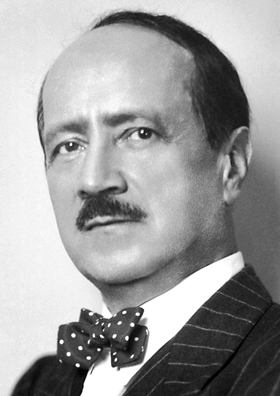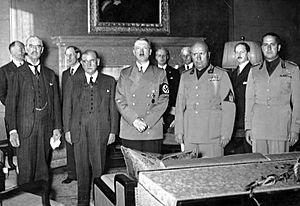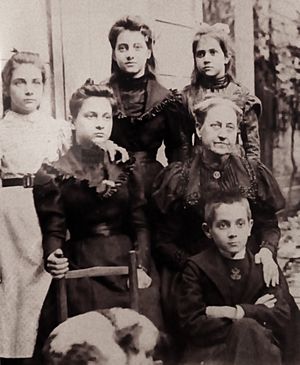Saint-John Perse facts for kids
Quick facts for kids
Saint-John Perse
|
|
|---|---|
 |
|
| Born | Alexis Leger 31 May 1887 Pointe-à-Pitre, Guadeloupe |
| Died | 20 September 1975 (aged 88) Giens Peninsula, Provence, France |
| Pen name | Saint-John Perse |
| Occupation | Poet, diplomat |
| Alma mater | University of Bordeaux |
| Notable awards | Nobel Prize in Literature 1960 |
Alexis Leger (born May 31, 1887 – died September 20, 1975) was a famous French poet and diplomat. He is better known by his pen name, Saint-John Perse. In 1960, he won the Nobel Prize in Literature for his amazing poetry, which was praised for its "soaring flight and evocative imagery." He worked as a top French diplomat from 1914 to 1940. After that, he lived mostly in the United States until 1967.
Contents
Growing Up
Alexis Leger was born in Pointe-à-Pitre, a city in Guadeloupe. This is an island in the Caribbean that belongs to France. His family had lived there since 1815. They owned two large farms, one for coffee and one for sugar. Alexis described his childhood in Guadeloupe as being "French as only the colonials are French."
In 1897, a new leader in Guadeloupe, Hégésippe Légitimus, came to power. He was not friendly towards the colonists. Because of this, Alexis's family moved back to France in 1899. They settled in a town called Pau. Young Alexis felt like an outsider there. He spent a lot of time exploring, fencing, riding horses, and sailing.
He went to Lycée Louis-Barthou and did very well in his studies. He then started studying law at the University of Bordeaux. When his father passed away in 1907, Alexis had to pause his studies because of money problems. But he eventually finished his degree in 1910.
In 1904, he met the poet Francis Jammes, who became a close friend. Alexis also spent time in cultural groups. There, he met other famous artists and writers like Paul Claudel and André Gide. He wrote some short poems inspired by the story of Robinson Crusoe. He also started translating the works of an ancient Greek poet named Pindar. In 1911, he published his first book of poetry, called Éloges.
Life as a Diplomat
Working in China
In 1914, Alexis Leger joined the French diplomatic service. This meant he would represent France in other countries. He spent his first few years working in Spain, Germany, and the United Kingdom. When World War I began, he worked for the government's press office.
From 1916 to 1921, he was a secretary at the French embassy in Peking (now Beijing), China. He lived in an old Taoist temple and said he "sat with the philosophers and sages." While in China, he traveled across the Gobi Desert and visited France's Pacific island colonies. He was very interested in the Gobi Desert. He wrote to a friend that these "desert expanses have exerted a hold on my thoughts."
A Poet in Paris
In 1921, Leger was in Washington, D.C., for a world disarmament conference. There, he was noticed by Aristide Briand, who was the Prime Minister of France. Briand asked Leger to be his assistant. In Paris, Leger met other writers and artists. He was a fan of classical music and knew famous composers like Igor Stravinsky.
Leger was seen as a rising poet in Paris. He became good friends with the famous writer Marcel Proust. While in China, Leger had written a long poem called Anabase. It was published in 1924 under his new pen name, "Saint-John Perse." He used this name for all his future writings. After this, he did not publish any more books for twenty years. He felt it was not proper for a diplomat to publish fiction. In 1925, he became Briand's chief of staff.

Leading the Foreign Office
After Briand died in 1932, Leger became the Secretary-General of the French Foreign Office. This was the top civil servant position. He held this job until 1940. He believed strongly in international "law and justice." He thought the League of Nations was a good place to solve problems peacefully.
Leger was very interested in Chinese culture. He hoped that both the Soviet Union and the United States would join the League of Nations. A British historian called him the "cold genius" of the Foreign Office. He was a brilliant diplomat, but he often worked for foreign ministers who were not as skilled.
One of the first big problems Leger faced was the Lytton report. This report said that Japan had acted aggressively by taking over Manchuria from China in 1931. Leger wanted the League of Nations to agree with the report. He thought this would help stop a war in Asia. He believed Japan was becoming too aggressive and moving away from international agreements. He worried that Japan's actions could lead to war. Leger argued that France should support sanctions against Japan. He wanted to protect France's colonies and interests in Asia.
Leger respected only one of the foreign ministers he served after 1932: Louis Barthou. He believed Barthou had a clear vision for French diplomacy. Leger wanted to keep the Locarno system, which was a set of agreements to keep peace in Europe. He felt it was the only thing that made Adolf Hitler respect France.
Leger was a close friend of Edvard Beneš, the leader of Czechoslovakia. He often supported Czechoslovakia. In May 1935, Leger went to Moscow with Prime Minister Pierre Laval to sign an alliance between France and the Soviet Union.
During the Abyssinia Crisis in 1935, Italy invaded Ethiopia. Leger was against a plan called the Hoare-Laval Pact. This plan would have given Italy a large part of Ethiopia. He thought it was wrong to reward Italy for invading another country. He secretly leaked the plan to the French press. This caused a huge negative reaction in France and Britain. The plan was stopped, and the British Foreign Secretary had to resign.
Leger believed that the re-militarization of the Rhineland in 1936 was a bigger turning point than the Munich Agreement. He thought that if Britain and France had stood up to Hitler then, he would have backed down.
In January 1937, there were rumors that Germany was sending troops to Spanish Morocco. This area was very close to the Strait of Gibraltar, an important sea route. Leger quickly protested to the German ambassador. He said that a German military presence there would threaten French interests. He also got a promise of British support. The Germans were angry about Leger's strong actions.
The Sudetenland Crisis
In April 1938, Leger attended a meeting about Eastern Europe. The main idea was that France's allies in Eastern Europe needed to work together to resist Nazi Germany. They discussed a plan for Romania to allow the Soviet army to pass through its land to help Czechoslovakia if Germany invaded.
Leger supported working closely with Britain. During the Sudetenland crisis, he agreed with the British policy of asking Czechoslovakia to make some concessions. He hoped that if Czechoslovakia gave in a little, Britain would then fully support them against Hitler. He went with French Prime Minister Édouard Daladier to the Munich Conference in 1938. There, they agreed to give part of Czechoslovakia to Germany.
After the Munich Agreement, the French Foreign Minister, Georges Bonnet, tried to remove officials who disagreed with his policies. Bonnet wanted to fire Leger, but Leger was protected by his friendship with Daladier. Leger worked to increase French economic influence in the Balkans. He was also present when France and Germany signed a friendship agreement in December 1938.
When Germany broke the Munich Agreement in March 1939 by taking over the Czech part of Czechoslovakia, Leger was furious. He argued that the French ambassador in Berlin should be called back to show how serious the situation was. He also complained to Daladier that Bonnet was not keeping him informed.
The Danzig Crisis
During the Danzig crisis, Leger strongly supported Daladier's plan for a "peace front." This was an alliance between the Soviet Union, France, and the United Kingdom to stop Germany from invading Poland. Leger was very annoyed with the Polish Foreign Minister, Colonel Józef Beck. Beck seemed unwilling to help Romania and was against allowing the Soviet army to pass through Poland.
Leger tried to get American public opinion on France's side. He sent French cultural figures to tour the United States. He believed that American support would be very important if France had to face Germany. He was surprised when Britain announced it would defend Poland in March 1939.
Relations between Bonnet and Daladier became very tense. Daladier started working directly with Leger, ignoring Bonnet. Leger learned that Britain was worried about Japan attacking its Asian colonies if a war started in Europe. He met with the American ambassador and told him about a secret German-Japanese plan to attack European colonies in Asia. This led the U.S. to move some of its navy to the Pacific.
Leger was against the Pope's offer to mediate the Danzig crisis. He believed it was a trick by Mussolini. He also thought that most church leaders were being controlled by the Fascist government.
French leaders wanted the Soviet Union to join the "peace front" more than British leaders did. Leger was annoyed that the British Prime Minister, Neville Chamberlain, did not want a military alliance with the Soviet Union. In May 1939, French leaders told the British Foreign Secretary that only an alliance with the Soviet Union could stop Germany. This convinced Britain to start talks with Moscow. Leger expected these talks to succeed.
Leger disliked France's policy of trying to improve relations with Italy. He believed that Benito Mussolini had already decided to ally with Germany. He thought that trying to win Italy over was pointless. Events later showed Leger was right, as Italy remained neutral at the start of the war.
Leger welcomed Britain's change in policy during the Danzig crisis. He knew that without British support, France could not face Germany alone. He also wanted Britain and France to give loans to Poland to help their military.
Leger was very angry with Colonel Beck of Poland. Beck refused to let the Soviet army enter Poland if Germany invaded. The Soviets insisted on this as a condition for the "peace front." On August 22, 1939, Leger advised the French government to pressure Poland to allow the Soviet army transit rights.
The Molotov-Ribbentrop Pact, signed on August 23, 1939, shocked French leaders. They had not expected Germany and the Soviet Union to sign a non-aggression pact. This made the "peace front" impossible. Some people blamed Leger for the failure, saying he moved too slowly.
After Germany invaded Poland on September 1, 1939, Mussolini suggested a peace conference. Bonnet wanted to avoid war and saw this as a way out. But Leger worked to stop Bonnet's plans. He had the French ambassador tell Britain that they should set a time limit for Mussolini's conference. This was the opposite of what Bonnet wanted. Leger also warned Daladier that the conference was a trick to stop France and Britain from declaring war.
When the declaration of war was finally written, Bonnet tried to delay it. But Leger made sure that the ultimatum to Germany would expire quickly.
Fired from His Job
On September 13, 1939, Daladier finally fired Bonnet as Foreign Minister. Daladier then became the acting Foreign Minister himself. Leger became the de facto (actual) French foreign minister until May 1940. Daladier often met with Leger and followed his advice.
In February 1940, an American official visited Europe to try to find peace. Leger told him that France was in a bad situation. He said, "The game is lost. France is alone against three dictators." He hoped this would make the U.S. send more aid to France.
Leger was close to Daladier. But after Daladier's government fell in March 1940, Leger lost favor with the new Prime Minister, Paul Reynaud. Reynaud's girlfriend disliked Leger and pushed Reynaud to fire him. On May 16, 1940, German forces broke through French lines. Paris was in a panic. Leger oversaw the burning of the Foreign Ministry's records to keep them from the Germans. On May 19, 1940, Leger learned from the newspaper that he had been fired. In mid-July 1940, Leger went into exile in Washington, D.C.
Later Life
In 1940, the Vichy government (the French government that worked with the Nazis) took away his honors and French citizenship. They also took all of his belongings. German soldiers looted his apartment in Paris and burned some of his unpublished poems. This made him very sad.
Leger was against the Vichy government. He lived in Washington, D.C., and had some money problems at first. But Archibald MacLeish, the director of the Library of Congress, helped him. MacLeish raised money so the library could hire Leger until he officially retired in 1947. He was offered a teaching job at Harvard University but turned it down.
During his time in America, he wrote several long poems. He stayed in the U.S. long after the war ended. He traveled a lot and enjoyed spending time with friends. He was also on good terms with Dag Hammarskjöld, who was the Secretary-General of the United Nations.
In 1957, American friends gave him a villa (a large house) in Giens, France. After that, he split his time between France and the United States. In 1958, he married Dorothy Milburn Russell, an American woman.
In 1960, he received the Nobel Prize in Literature. After winning the prize, he wrote more long poems. In 1962, the artist Georges Braque created a series of etchings (a type of printmaking) for Perse's poem Oiseaux (Birds).
A few months before he died, Leger gave his library, writings, and private papers to the Fondation Saint-John Perse. This is a research center dedicated to his life and work in Aix-en-Provence. He passed away in his villa in Giens and is buried nearby.
His Books
- Éloges (1911)
- Anabase (1924)
- Exil (1942)
- Pluies (1943)
- Poème à l'étrangère (1943)
- Neiges (1944)
- Vents (1946)
- Amers (1957)
- Chronique (1960)
- Poésie (1961)
- Oiseaux (1963)
- Pour Dante (1965)
- Chanté par celle qui fut là (1969)
- Chant pour un équinoxe (1971)
- Nocturne (1973)
- Sécheresse (1974)
- Collected Poems (1971)
- Œuvres complètes (1972) - This is the full collection of his work.
Tributes and Honors
- A bronze statue called Hommage à Saint-John Perse was placed in a garden in Paris in 1992.
- A bronze mask of Saint-John Perse was made by András Beck.
- The Saint-John Perse Museum in Pointe-à-Pitre, his birthplace, is partly dedicated to him.
- Many streets and libraries in France are named after him.
- A Reims tramway station also carries his name.
- In 1980, the French Post Office released a stamp honoring him. In 2001, the British Virgin Islands also issued a stamp with his image.
- The Saint-John Perse high school in Pau is named after him.
See also
 In Spanish: Saint-John Perse para niños
In Spanish: Saint-John Perse para niños
- Le Monde's 100 Books of the Century, a list which includes Amers
|



